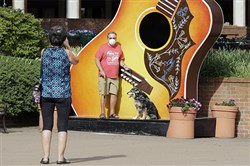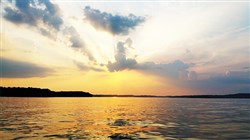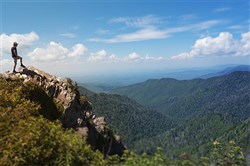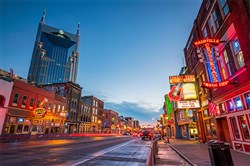VOL. 44 | NO. 45 | Friday, November 6, 2020
Mother Nature saves 2020
By Joe Morris
Tourism officials love gaudy economic-impact numbers. Tennessee’s most recent report on travel doesn’t disappoint, offering up record-breaking figures that are the envy of many other states. Unfortunately, the report is for calendar year 2019.
It’s a safe bet that 2020s tally won’t be as rosy, but the ever-optimistic tourism community says that even so, the picture is far from bleak.
That’s because officials across the state have been actively recalculating and recalibrating everything from marketing and outreach to business and attraction reports during the pandemic-related shutdowns and downturns.
Coupled with assistance and support from the state, that’s already meant an upswing after a very bleak spring, a fingers-crossed mentality about the remainder of 2020 and a renewed drive to make 2021 a comeback year.
In order to put the severity of 2020 in context, a visit to 2019 is in order.
The 2019 Economic Impact of Travel on Tennessee report, recently released by the Tennessee Department of Tourist Development, shows the state posted solid tourism stats from one end to the other, top to bottom.
Tennessee hit a record-high $23 billion in domestic and international travel spending, capping a decade of consistent growth. Tennessee also saw 126 million domestic person stays in 2019, up 5.7% from 119 million in 2018.
As a group, those visitors spent an estimated $64 million per day. All those dollars fueled $1.92 billion in state and local tax revenues, a 5.9% increase and more than a point higher than the national growth rate; $5.22 billion in payroll, and a 195,000-member workforce.
Nashville and Davidson County led the way with $7.5 billion in tourism economic impact. Shelby County followed at $3.8 billion, then Sevier County clocked in at $2.6 billion, Knox County with $1.22 billion and Hamilton County at fifth with $1.21 billion.
The phrase “record-shattering” was used by the state when announcing these numbers, and they indicate a very robust destination as a whole, says Mark Ezell, commissioner.
“It was another record year for travel expenditures and job creation,” Ezell adds of 2019. “All the metrics we aspire to, we accomplished. We benefited from the groundwork that was laid by things like Ken Burns’ country music series, which will be sending people to Nashville and the rest of the state for several years as they view it. And of course, there was the NFL draft in Nashville, which brought 600,000 people in. We have a lot of assets, and we were leveraging them all.”
In addition to urban activities, the state also benefits from its myriad outdoor opportunities. Anchored by the Smokies in the east, the state offers, rivers, lakes, hiking and more across its breadth. That helps in a normal year, and it was a lifeline in 2020.
Nashville’s conventions COVID-19 downturn by the numbers
Meeting/convention changes through 8/28
• The NCVC is aware of 1,325 meeting/convention cancellations representing 1,056,084 room nights & 694,248 attendees.
• These meetings were expected to generate $527.74 million in direct spending, $42.59 million in state taxes, and $45.44 million in local taxes.
• 146 of these groups have postponed/rebooked for future dates, with 116,123 room nights, 614,435 attendees, and $54.33 million in direct spending
Travel Trade Cancellations
• The NCVC is aware of 1,594 travel trade groups with 61,914 attendees that have canceled trips through the end of 2020, which were expected to generate at least $28.59 million in direct spending
“Having those outdoor assets became very important when COVID-19 hit,” Ezell says. “Our state parks, streams, lakes and mountains became a focal point when sheltering at home began to be eased, and people wanted to get outside – but do so safely.”
And after a horrible March and April, businesses were clamoring to stretch their legs, as well.
After seeing some early misfires around poor social distancing and flare-ups in COVID cases, the state attempted to do its part by rolling out the Tennessee Pledge, a series of guidelines designed by the Tennessee Economic Recovery Group, a public-private partnership set up by Gov. Bill Lee in April. These were developed for businesses and organizations statewide and are routinely updated to reflect virus spikes and any other news on the ground.
They factor in recommendations from the Centers for Disease Control, Occupational Safety and Health Administration, Tennessee Department of Health and private sector partners. The goal, Ezell says, is to make sure the entire tourism community, especially hard-hit rural areas that sometimes struggle for visibility, have a template.
“One thing we are seeing is that a lot of our small towns are getting more visitors, because people can’t congregate for things like a big concert or sporting event,” Ezell notes. “They still want to do something, and so we’re seeing a benefit for our smaller operators and we want to make sure they can continue to benefit from that.”
Metro areas continue to struggle with tourism-related issues around hotel occupancy levels and the resulting reduced room rates and sales tax income. That’ll continue to affect local and state coffers for a while, Ezell says, and will keep those players front and center of any state, or state and local, revival efforts. And those are already underway.
“We see the state’s tourism community coming back already; not to 2019 levels, certainly, but great steps from where they were in the spring,” Ezell says. “They are joining mask movements, they are following the Tennessee Pledge guidelines, they are doing the right things so they can recover.
“There is plenty of demand. When the Country Music Hall of Fame and Museum reopened, they sold 300 tickets in their first hour.
“At the Bristol Motor Speedway, the all-star race was held with masks mandated and social distancing; they dismissed people in rows, like you’d see at church, and they had around 25,000 people. That’s certainly not full capacity, but we know we can’t have full stadiums now.

Denise Stromberg and husband Scott, alomg with their dog Bogie, made a stop in Nashville on their way from Florida to their home in Lincoln, Nebraska, this summer despite COVID-19 closings.
-- Photo By Mark Humphrey | Ap“That’s telling us that if our operators can provide a safe experience, folks will come to see them.
“We have the brand, we have the assets, now we need to start rebuilding.”
Nashville turns up volume
The tourism juggernaut that is Nashville continued undaunted in 2020. It skidded to a stop in March 2019 when the COVID-19 pandemic hit, and what had been a reliable economic engine suddenly found itself sputtering.
Local tourism officials say Nashville lost $2.86 billion in visitor spending due to COVID through Aug. 29 with a tax loss from mid-March to Aug. 29 of $109 million. Nashville is likely to lose another $1 billion in visitor spending by the end of 2020.
But thanks to a ground game built in the early days of sheltering at home back in March, there are positive signs, says Butch Spyridon, president and CEO of the Nashville Convention & Visitors Corp.
“Those 2019 numbers exceeded our expectation, and we like leading the state in both dollar and percentage,” Spyridon says. “That was a huge accomplishment. It would have been nice if we could have kept on going.
“But what those numbers do allow us to say is that our growth has been consistent, as has our year-round performance. We’re still doing better in June than in January, but we’ve made great strides toward becoming a year-round destination because we continue to get great press around the world and continue to expand the interpretation of our brand.”
A big and fast-moving train is harder to stop, so when Tennessee effectively shut down in March 2020, Nashville’s tourism, restaurant and retail communities had to really stand on the brakes. There were some bad looks then and in the following months – social media photos and footage featuring packed bars on Lower Broadway without a mask in sight – which led to calls for better enforcement and penalties for bad actors.
Even so, Spyridon says that the vast majority of the entertainment and tourism-driven community played by the rules and is beginning to reap the benefits of having done so.
“We have great reopening plans, protocols and guidelines, and so far, those are working great,” he says. “People are following the rules better, and businesses are complying.
“We’re in a good spot to open up. What we’re hesitant on is marketing, because we want to make sure our recovery is gradual, and so is sustainable. We want to encourage visitors but do that slowly so we avoid a backslide that nobody wants and that we can’t afford.”

Percy Priest Lake, pictured here, and other area waterways saw an uptick in traffic this year as locals and tourists sought recreation away from crowds.
-- Shutterstock.ComThat means nonstop messaging around a ‘come back – when it’s safe’ theme, which will cover everything from neighborhood restaurants to larger bars and entertainment venues to the all-important conventions that generate millions in tax revenues.
“We’re united in our messaging from the state down, and I give Commissioner Ezell a lot of credit for helping to encourage our surrounding counties to implement a mask mandate when they did,” Spyridon adds. “I hope they think hard about relaxing those, because I think masks are going to be the ticket to our surviving the pandemic. We have to stay on top of the safety issue.
“If wearing a mask helps cut down transmission it’s a small price to pay, and I think our businesses agree that if that’s what’s needed to help them get back open, then we need to keep doing it.”
On the convention front, Spyridon says his organization is targeting March 2021 as a “legitimate recovery month” in hopes that a vaccine may be in sight by then. He and his team are meeting with hotels to help them plan for a period when they’re not limited to 125 guests, or only getting guidance for two-week periods, around those occupancy rates.
They also are working with some large conventions that postponed, rather than canceled, to get them into town. Those include the National Cattlemen’s Beef Association, and Hearth, Patio & Barbecue Association, among others.
“Those are booked, and we want to hang on to them, so we have to find a way to host them,” Spyridon points out. “And that will help us with the logistics and planning for others. All these events are going to be smaller than they might have been, but conventions are 42% of our business and we simply have to get some of that back.”
And in the meantime, the Convention and Visitors Corp. will continue with the smaller steps it deems as essential to bridge the gap between 2019’s record-breaking year and where the city finds itself. Now.
Those include the “Love Thy Neighborhoods” campaign kicked off to help local businesses replace the $100 million a week the Convention & Visitors Corp. says they have been losing in visitor spending, and a Music City Bandwidth, a partnership with Nashville’s Music Venue Alliance to produce 30 virtual concerts in 15 different venues that will be streamed online. The effort is expected to give 120 musicians work during a time when there are few if any opportunities to play for live audiences.
“This has gone on longer than we thought it would back in March, but I think maybe we’ve got a handle on what is ahead,” Spyridon says.
“We have had less recovery than we anticipated in May, when we laid out a new trajectory, but we are still seeing signs of improvement and so we have to work from that.”
Mountains are calling

Visitors to the Great Smokey Mountains, both on foot and in the safety of their cars, has helped Sevier and Knox counties tourism this year.
-- Shutterstock.ComAs the Great Smokies have proven, mountains are a durable attraction regardless of flood, fire or now pandemic. And while Knoxville has long hung its tourism hat on their proximity, a strong showing in 2019 highlights the other activities and getaway opportunities the area has to offer, says Kim Bumpas, president of Visit Knoxville.
“We were certainly excited about having a record year, and really held our own as the fourth largest producing county in the state,” Bumpas says. “The overall report showed so much momentum for the state, and also for Knoxville and Knox County.”
And then, the COVID-19 pandemic shuttered bars, restaurants, hotels and venues. In addition to keeping tabs on stakeholders, Bumpas notes she and her team used that time to try to plan ahead.
“We pulled back on any major marketing, and at the same time came up with ways to put Knoxville in a potential visitor’s ear,” she says. “We put out and promoted a lot of virtual events, drove a lot of video content on our social media. All of that was talking about things to do when it was safe to travel again, and here are some reasons why you should visit Knoxville. That helped us at least create awareness in March and April.”
Knoxville’s “low of lows” came in April when the city posted 4.4% hotel occupancy downtown and 22.6 occupancy countywide. By May, Bumpas says it was important to open up some marketing, “at least a little bit,” to capture people looking for outdoor, socially distanced activities. That has held steady since then, and other venues and activities have been slowly added into the mix.
Since May, hotel occupancy has also crept back up. In July, Bumpas says it was around 51% countywide and climbed to more than 79% in August for the downtown area.
“Our daily rates have come back up as well, and we’re holding our own and kind of hovering right now,” she explains. “We feel really good about that, because fall is always a very dynamic season here and I think this year will be as well. We fit the COVID model of ‘where can I go when I want to get out of the house’ because we’re drivable, economical and have a ton of outdoor experiences.”
Leading that roster would be drive trips into the Smokies to see fall foliage. People can stay in their cars, reducing if not eliminating the need to be near other people, socially distanced or otherwise.
“We’re promoting the idea of staying in Knoxville, travel up to see the leaves, and doing that with our partners in Sevier County and Dollywood,” she adds, “so people can also stay there and then come down here for things to do. We’re also working with our partners around the state, because we all have outdoor activities in our markets, and we can help each other a lot with cross-promotional activities.”

Nashville’s Lower Broadway during the height of the pandemic
-- Shutterstock.ComAs far as 2021 goes, Bumpas predicts a continuation of her “slow and steady” approach. Many conventions that were on the books for 2020 have moved to 2021 through 2023, so there is upcoming activity. And when a COVID-19 vaccine is announced, she says Knoxville will be ready.
“We are a destination now; groups are booking,” she says. “But there is still a sense of lingering. When it’s fully safe, we think a lot of conventions are going to come in, and some that have booked further out may adjust backward. The big thing is, we are seeing rebooking versus cancellation. We have had backup plans, and backup plans to the backup plans, just like everyone else.
“But sooner or later things will look at least a little bit more normal, and so we’re always reassessing our situation so that we can leverage all our positives, from our venues and outdoor activities to our airport and general location, to drive our visitor and convention traffic back up to where it used to be – or even better.”
Chattanooga opportunities grow
The calm before the COVID-19 storm for Tennessee tourism was also very good for Chattanooga, says Barry White, CEO of the Chattanooga Tourism Co.
“Any time you can enjoy a 5% increase and positive movement, that is very good,” White acknowledges. “We were also really pleased to see how well other markets, and the state overall, did.”
Chattanooga is very much a legacy tourism destination, with attractions such as the 125-year-old Lookout Mountain Incline Railway and Rock City and Ruby Falls celebrating their 80th and 100th birthdays.
More recent additions such as the Hunter Museum of American Art, Tennessee Aquarium and Creative Discovery Museum have been layered on in recent years, building a solid hub of things to do see and do for all ages.
“That whole package makes us first and foremost a great family destination, and then we are able to offer a very full menu of outdoor recreation opportunities,” White says. “That was a positive for us before the pandemic, and it has helped us since earlier this year.”
The last few months have been a period of “hanging on and planning ahead,” White notes, adding that Chattanooga was running about 9% ahead of its strong 2019 numbers before the bottom fell out.
“During the shutdown, we did a lot of inward focusing, looking at our community and seeing what resources we could provide,” he explains. “We had weekly conversations with our hospitality industry, and every single day were hosting calls for restaurants, hotels, attractions and other industry partners. There was something going on every single day to help us all figure out how we could get through this. And when the different stimulus packages became available, we shared as much information as we could, acting as a clearinghouse to offer even more support.”
As in the state’s other urban areas, advertising and marketing took a back burner during this other activity. Once incremental reopening began, any efforts were targeted to those looking for outdoor activities, where they would feel safe.
“We knew as attractions opened up, even in limited capacity, we could then begin to position them in promotions alongside outdoor recreation,” White says. “What we want to do is instill confidence that you can come here and still be safe. Our position as a drive market has always been an advantage and continues to be one today. Now we are working with the state, and with our other partners around the state, to back up that message. We want people to come here, to be safe, and to enjoy all we have to offer.”
On calls with other stakeholders that are organized by the state, White says he and his counterparts are sharing all kinds of information – including lessons learned.
“We’re all focused on how best to reopen safely, and to stay open and grow capacity,” he continues. “But we’ve also all talked about the unique things that have happened in our areas, and how we’ve had to learn to do things differently. We’ve gotten creative and smarter, with things like curbside pickup versus in-restaurant dining. I think those avenues of revenue for dining will stay with us and grow.
“And our attractions have learned to manage flows and crowds, and then proven success of that means those tools will stay in place as well. We’re all a lot more conscious of health and safety now, and so you’re going to see things like hand-sanitizer stations as a pretty routine thing. And that’s not bad – flu season comes every year and having visible ways to promote good health and protect the health of others will be good for all of us.”
Back at the state level, Ezell says multiple goals are in place: Tracking unemployment, health measures, reopening plans and much more. No one is where they want to be right now, but collaboration has proven to benefit players in all the state’s market versus just here and there.
“We are tracking the recovery through spending across restaurants, accommodations and many other sources,” Ezell says. “We are following federal relief programs, helping to connect people to funds. Nobody is happy right now; COVID-19 has taken lives and impacted people financially, in the businesses they own and in their lives. Having said that, we are out in front as best we can to reopen our tourism economy with safety measures that will help businesses stay open and livelihoods to be restored.
“It is still a very challenging time with a lot of work to do,” he continues, “but if we keep doing things the right way, we can continue to survive and, in some places, even thrive during this pandemic. We need to keep doing what we are doing until a vaccine gets here and keep track of all that we are learning along the way.”